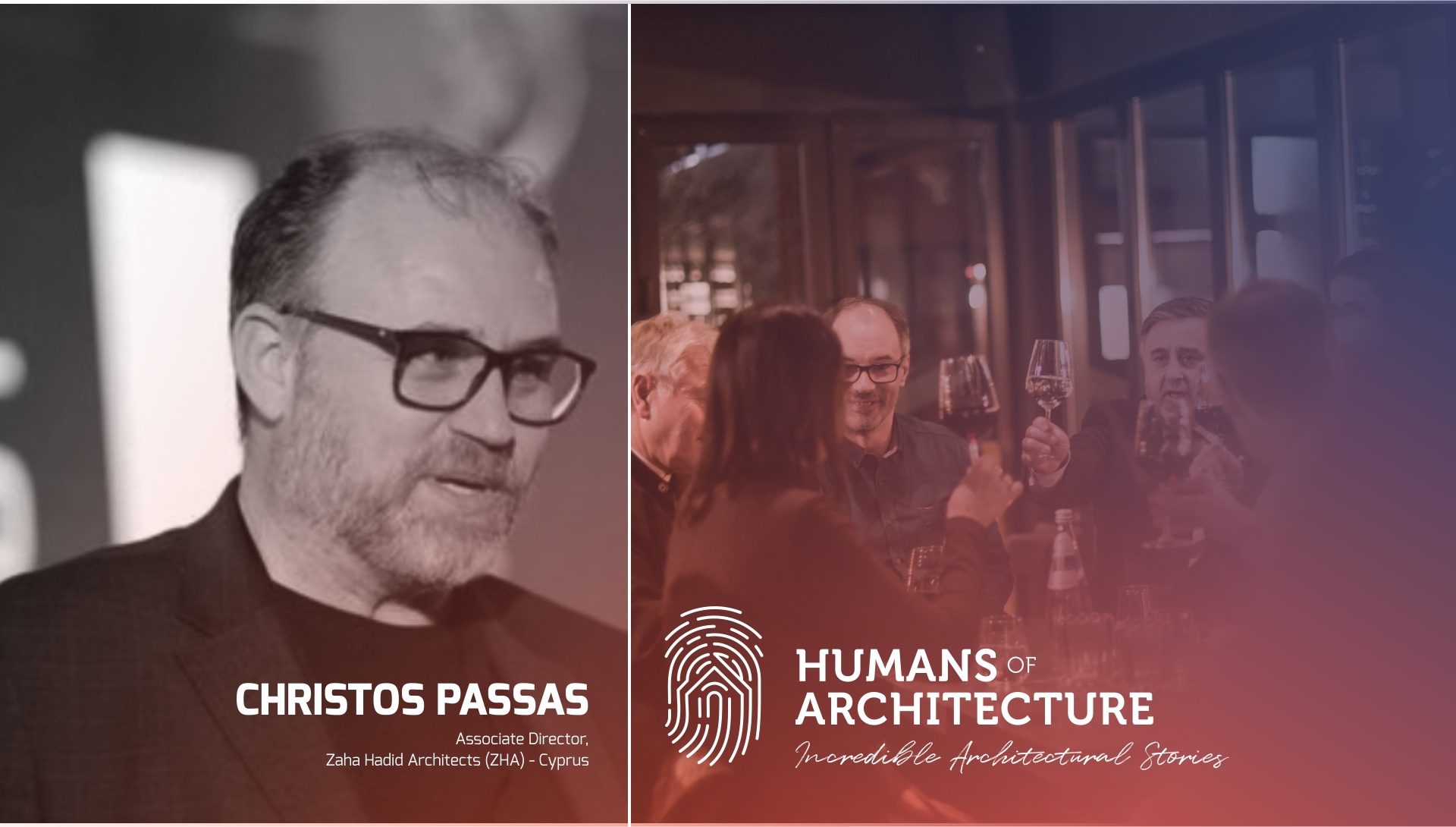In Dialogue with CHRISTOS PASSAS
“I’ve worked with Zaha Hadid for 21 years – soon to be 22.(…) Architects don’t build buildings – they design buildings geometries and define the immaterial aspects of architecture. Architecture with a capital ‘A’ encompasses all sorts of different things – emotional intelligence referring to the materials and colours or the psychology of the place and the way it interacts with you. Architecture is not only about buildings – it’s the whole process behind it.”
Christos Passas: Yes! I’ve worked with Zaha Hadid for 21 years – soon to be 22. When I was three years old – the age of my daughter – I remember being in my grandmother’s arms as she was showing me the moon for the first time. I was barely three years old and I remember being overcome with feelings of love for the beauty that I could not touch. This is the gift that my grandmother gave me. When the war in Cyprus broke out, my family was living in a city called Famagusta – a city that has remained a ghost town until today. We were refugees, we fled the city and while the Turkish troops were moving towards the city, the United Nations stepped in because there was a big refugee problem. I remember two things from that period: one was my first kindergarten being literally in a trench with a piece of metal on its top and the fact that I didn’t care about these things as a baby, but cared that my kindergarten teacher always wanted to make me comb my hair in a way I didn’t like [laughs]. I grew up and I was starting to feel suffering for a loss I couldn’t really define.
Andreea Movila: What kind of loss?
C.P.: The loss of home and the family structure. It was quite dramatic for all of us, but it also taught me that you don’t need anything in life – the only thing you have to invest your time in on this planet is the energy that you posses and you can invest it in the way you like.
When I was 17 I was extremely bored and didn’t know what to do with my life because I felt totally dissatisfied with everything that was going on in our hometown. Starting studying was really appealing and exciting because it was amazing to be involved in an environment focused on learning. When I went to the United States I was still feeling small and probably insecure in a big city like New York, but at the same time every day brought up new things and I was lucky enough to meet some good teachers who taught me a lot of things. You know, life is not only taking from you, it also gives you things.
I graduated in New York, a beautiful city with so many things going on… I wish I knew more about New York when I was living there, but as it happens with me, I never fully grasp the moment I’m living – I only see later how beautiful things were [laughs]. When I finished I went to the AA in London. Because I was on a scholarship visa, I had to go back to Cyprus and respect the agreement to give back what I received from my country and I was happy to do it.
However, at some point I said ‘Even if I come now, you don’t have space for me there’ not because I was arrogant, but because if I am going to practise architecture I can’t be doing a two-story house or a five-story apartment building – we need to do better! So I asked for permission to stay in London and they gave it to me. After I graduated from the AA, I went to Zaha and today I am still there.
A.M.: I must point out that this is very, very impressive!
C.P.: I went there for a year and we worked hard – we were working day and night.
A.M.: Was the period from the beginning tough?
C.P.: Yes, the first nine years were very tough [laughs]. Our office is like a solar system and we used to call it Hotel California – a lot of people have come and left.
A.M.: How did she manage to keep you there fully committed to the office? What was the ‘ingredient’ that made you stay there?
C.P.: I was given this ingredient by my parents who taught me to be committed and work hard. They were very supportive and in some way Zaha was also lucky to find people like us. I think she had created an environment where everything was about research and this became a very good place to work for young architects who possessed this kind of ethic. It wasn’t restricted – you could try out different things and fail again and again until you made it.
A.M.: How did you find the resources to start over again and have the resilience to go forward?
C.P.: Well, at some point I crashed. After the Phaeno Science Centre has been finished I used to go to Germany once a week. We were working very hard at the time because it was an extremely challenging project with lots of small complications. You know, clients want big buildings but they do not want any responsibility that comes with them.
A.M.: There are situations in which very creative people are not capable of managing their business. How did Zaha manage it like a business, make it work and make it profitable?
C.P.: We have people who manage the business very well. The team has different skill sets but we just went out and did the things we had to do in order to make the project happen. As we were building our first buildings, the money and the right management people came in and this helped us develop for the better.
A.M.: What do you think the best legacy she left is?
C.P.: She allowed architects to experiment – she created a bubble where architects could do their work and not be subjected to all the nonsense that’s being thrown at them. Zaha was in many ways a big umbrella for all of us and taught us that the only thing in architecture is to allow things to happen – allow women to be good architects, reward them for it and allow men to do things that are not usually done by men. She always felt that it was a ‘men against women’ kind of thing, but it’s not! It is the struggle that you have as a creative person – a struggle that the others cannot feel; and to bring the architectural profession to the point where it is considered creative and not just productive makes a lot of difference. We are designers – we’re not the builders of the work. Constructors build the work. I produce the drawings, the worker has to build it somehow but it has to do it according to the drawings. When the computers came we could visualise the geometries better and analyse everything else easily.
A.M.: That helped her philosophy and vision significantly. Was there any time when she felt that her position as a woman architect from a foreign country affected the project?
C.P.: She hasn’t built anything for twenty years! It’s unusual for an architect not to build anything for twenty years, especially if you consider that she had a show in MOMA along with the best architects in the world and nobody gives her a job to do! She was a bit aggressive and explosive, but who wouldn’t be given all that pressure and prejudice as well?
A.M.: Being able to stay with her so much time as a collaborator…this is very impressive! I think it was her chance to meet you and now that she’s gone… anyway eternity means to be loved by as many anonymous people as possible.
C.P.: The beauty of life is that it doesn’t end when one of us goes away. We are in a chain – some of us go away, some others come in – and having these common experiences brings us together. Life is what it is and it goes on.
A.M.: What values do you appreciate the most in an architect?
C.P.: The willingness to learn and the curiosity about architecture, the world and the work we do. He has to know a bit about the buildings we’ve done and have some sort of affinity. All in all, he has to be curious and hard working not because we want them to work 24 hours a day, but because I think it’s good for them to be committed to something. Maybe I am unfair, but I hear a lot of people complain that today’s generation don’t commit easily to something because they want to be trapped or don’t want to over-commit. I think that commitment is the tool that helps you achieve what you want. I think that commitment really delivers and browsing does something else. It takes 7 to 10 years to finish a building, so if you’re not committed you’re only catching snippets of a process that is otherwise very informative.
A.M.: We are also architects of information at certain points because we analyse some data and invest it with a meaning in order to get information.
C.P.: As I previously said, architects don’t build buildings – they design buildings geometries and define the immaterial aspects of architecture. That’s what we do and then we chase those who build them to build in the same way. Architecture with a capital ‘A’ encompasses all sorts of different things – emotional intelligence referring to the materials and colours or the psychology of the place and the way it interacts with you.
Architecture is not only about buildings – it’s the whole process behind it and you realise this when your start designing or try to understand how cities work. The molecule which is the building explodes into a thousand buildings and then you have to start the relationships between them – only then you can start thinking about designing entire countries by identifying the relationships between the cities. It’s about understanding co-dependence and interactivity and all of the things that relate to intelligence directly.
If you remember some of the diagrams I showed you about time programming for some buildings, I usually show those together with a brain scan so that you can understand how a city and the brain work in the same way – different regions activating at different times.
Communication becomes a powerful tool – that’s why it takes many people’s intelligence to design the buildings, it is multiplicative – it doesn’t add up. If you have two brains than one plus one is not two – it’s more because there is a space in between the two, the communication between them which is a form of intelligence as well. Maybe it’s exponential. The cities work in the same way: a singular building cannot perform in the same way a city works. Ten buildings disconnected from each other will never work the same way a well organized city works.
A.M.: How does your office position on the topic of artificial intelligence?
C.P.: We don’t really use artificial intelligence in the office – we do scripting, make algorithms and code and sometimes work with big data but the analytics are different from artificial intelligence. Frankly, what is called artificial intelligence today is not very intelligent.
A.M.: Yes, programming something to do what you want – it’s not like it learns by itself and comes up with innovative outcomes.
C.P.: People are concerned about AI and we should be as we don’t even know what it is yet, so we don’t understand something we are naturally afraid of it. However, somebody told me a while ago that maybe artificial intelligence will give us a chance to learn more about ourselves.
A.M.: Indeed, freeing us by a lot of jobs will give more time for reflection.
C.P.: Unfortunately, no government wants free thinking individuals because free thought is a threat.
A.M.: How you perceived the evolution of the field over time?
C.P.: Our profession changes but not fundamentally. In other words, if I go back and think about how the Egyptians built the pyramids I’m pretty sure there were some architects – whether by title or by function – who were systematising the whole process. I’m not sure they came up with a pyramidal shape or not, but I don’t think it matters that much.
In ancient Greece, when they built the The Parthenon there were architects and we also know their names – Iktinos and Callicrates. They were basically sculptors but were called artists because they were the ones defining the form of the building – they were basically master builders who taught everybody else how to do it. It’s a similar story with the people who built Hagia Sophia in Constantinople and if we come back to the modern years, I think there was an attempt to redefine the role of the architect with Le Corbusier who wanted to separate the conceptual architect from the building architect; when he was working abroad he would design the outline of buildings and the local people would then build.
They didn’t have emails or Skype and it was a necessity as well, but that kind of intellectual forward thinking is a little bit dull today – who wants to just draw an outline and get somebody else to do it? Today we work across the world and the technology enables much more than what Le Corbusier had when he had to travel for three months to go from Paris to New York. We’re doing it instantly today – when we work in China there’s day time in London, so we mail the Chinese colleagues and they pick them up right away.
We do a lot more research today – it is not only empirical but it’s also theoretical, material and design research because these new technologies integrate our processes a lot better. I can be directing a team that has Grashopper scripters and planers and they are all working together. Now am I doing a fundamentally different job from what Iktinos and Callicrates were doing? I don’t think so – it’s just that the tools change and the question is ‘Does that mean that the fundamentally immaterial reality changes?’
A.M.: The basic human needs do not change during time. However, referring to the Maslow’s pyramid, the top of the pyramid – self actualization, as a critical needs is more visible now than ever.
C.P.: The system is more democratic today – you can have more leaders at the same whereas you couldn’t have this in the Medieval Era. Andy Warhol said ‘Everybody’s famous for 15 minutes’ but at least we start understanding through this process the plurality of our world. That’s why I like your idea of the ‘Humans of Architecture’ series – it shows the plethora of thoughts and conversations and that is almost like an antidote to the mass-media and social media brainwashing that is going on daily.
A.M.: What is your main source of happiness from architecture?
C.P.: Architecture doesn’t offer me happiness. I must be honest with you – all my time away from architecture offers me happiness. Architecture gives you a sense of accomplishment but my happiness is in a different place. There is architecture in that environment too but it’s not tangible. It’s all about seeing my kid in the morning, laughing, seeing my family having dinner together – these are the things that matter for me.
A.M.: In a sense people are the architects of their lives.
C.P.: Architecture is a painful profession because it takes a lot of energy, sacrifice and time away from those things you ought to be doing. It takes commitment because it is a practice, you cannot get out of it. How many architects who retire at 65 do you know? What’s the point in stopping?
This is a life-long identity. For example, when we built Phaeno, seeing those kids going inside playing in the museum made me buy a ticket because nobody knew who I was. I just stood there, looked around and realised that it gratified me because I was one of those kids.
However, I also understood that I was not the only one contributing to that thing… I learnt a lot from Zaha during that time, I learnt from our German colleagues a lot, I learnt from my team in the way we worked and the mistakes I made – some of them still haunt me today, but they were learning experiences. We can’t design buildings that make people happy, nor should we connect people’s happiness with the buildings. Shelter, pleasure and functionality are separate things.
Why would you want to dedicate happiness to architecture? If you’re in a park on a sunny day and you feel happy in it, it is your state of mind. Happiness is not permanent.
A.M.: [laughs] Thank you for your time!




